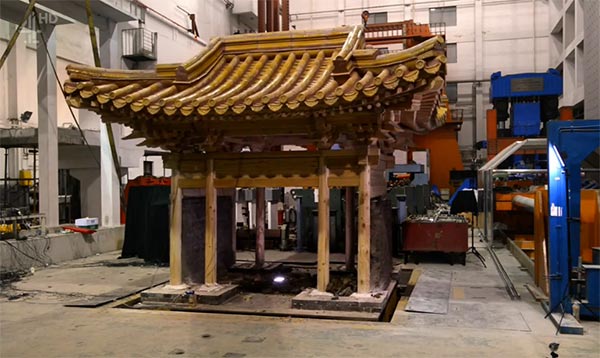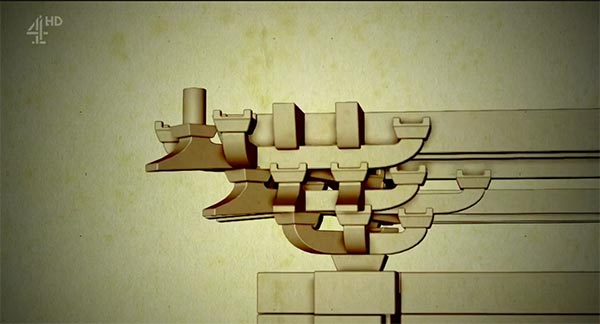


A resident seismologist of the Forbidden City, surnamed Zhou, created a shake table calibrated to the size and weight of a 1:5 scale model of a typical building in the palace to replicate the energy of quakes in increasing magnitude and simulate how much quake forces the architectures can take.
Under a simulated earthquake of magnitude 5, walls around the model pavilion began to crumble but the pavilion stood upright in its complete form. At magnitude 9.5, an energy equivalent to 200 tons of the explosive TNT, the supported columns started to move but did not crack. At 10.1, the highest level tested, the pavilion still stood high.

A simulated model of dougong. [Photo/Screen capture of Secrets of China's Forbidden City]
The secret can be summarized in one word -- flexibility.
The dougong acts like a shock absorber in a car and there's both friction and rotation that absorbs the energy from the earthquake.
Something as simple as a craftily cut piece of wood, that was designed more than 2,000 years ago, reached their zenith in the Forbidden City and protected the impregnable fortress from natural disasters for centuries.

A scene from Secrets of China's Forbidden City. [Photo/Screen capture of Secrets of China's Forbidden City]
The vision of one man may have wanted to steer China into a whole new direction, but it was the genius of the Chinese people that made it possible.
Secrets of China's Forbidden City is a co-production between China Intercontinental Communication Center and BBC.
 |
 Fire brigade in Shanghai holds group wedding
Fire brigade in Shanghai holds group wedding Tourists enjoy ice sculptures in Datan Town, north China
Tourists enjoy ice sculptures in Datan Town, north China Sunset scenery of Dayan Pagoda in Xi'an
Sunset scenery of Dayan Pagoda in Xi'an Tourists have fun at scenic spot in Nanlong Town, NW China
Tourists have fun at scenic spot in Nanlong Town, NW China Harbin attracts tourists by making best use of ice in winter
Harbin attracts tourists by making best use of ice in winter In pics: FIS Alpine Ski Women's World Cup Slalom
In pics: FIS Alpine Ski Women's World Cup Slalom Black-necked cranes rest at reservoir in Lhunzhub County, Lhasa
Black-necked cranes rest at reservoir in Lhunzhub County, Lhasa China's FAST telescope will be available to foreign scientists in April
China's FAST telescope will be available to foreign scientists in April "She power" plays indispensable role in poverty alleviation
"She power" plays indispensable role in poverty alleviation Top 10 world news events of People's Daily in 2020
Top 10 world news events of People's Daily in 2020 Top 10 China news events of People's Daily in 2020
Top 10 China news events of People's Daily in 2020 Top 10 media buzzwords of 2020
Top 10 media buzzwords of 2020 Year-ender:10 major tourism stories of 2020
Year-ender:10 major tourism stories of 2020 No interference in Venezuelan issues
No interference in Venezuelan issues
 Biz prepares for trade spat
Biz prepares for trade spat
 Broadcasting Continent
Broadcasting Continent Australia wins Chinese CEOs as US loses
Australia wins Chinese CEOs as US loses